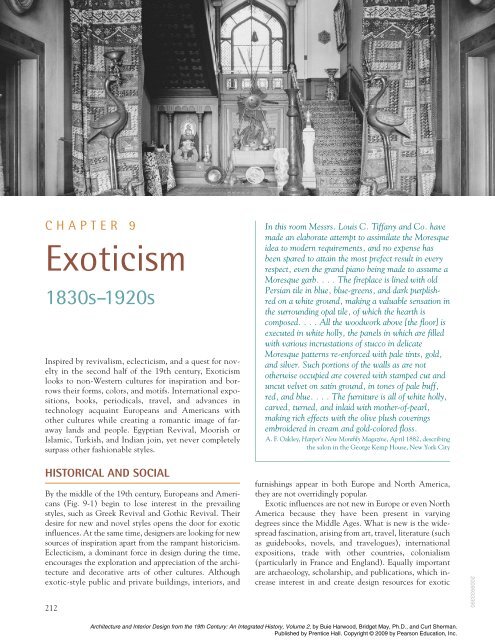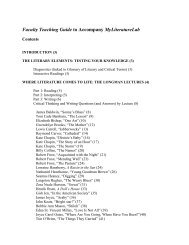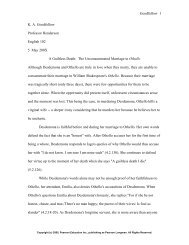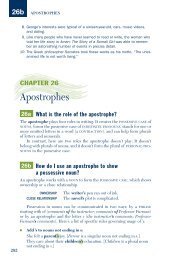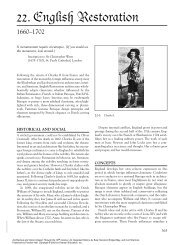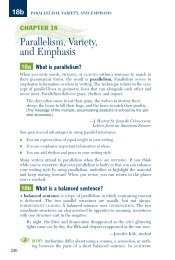Chapter 9 - Pearson
Chapter 9 - Pearson
Chapter 9 - Pearson
Create successful ePaper yourself
Turn your PDF publications into a flip-book with our unique Google optimized e-Paper software.
CHAPTER 9<br />
Exoticism<br />
1830s–1920s<br />
Inspired by revivalism, eclecticism, and a quest for novelty<br />
in the second half of the 19th century, Exoticism<br />
looks to non-Western cultures for inspiration and borrows<br />
their forms, colors, and motifs. International expositions,<br />
books, periodicals, travel, and advances in<br />
technology acquaint Europeans and Americans with<br />
other cultures while creating a romantic image of faraway<br />
lands and people. Egyptian Revival, Moorish or<br />
Islamic, Turkish, and Indian join, yet never completely<br />
surpass other fashionable styles.<br />
HISTORICAL AND SOCIAL<br />
By the middle of the 19th century, Europeans and Americans<br />
(Fig. 9-1) begin to lose interest in the prevailing<br />
styles, such as Greek Revival and Gothic Revival. Their<br />
desire for new and novel styles opens the door for exotic<br />
influences. At the same time, designers are looking for new<br />
sources of inspiration apart from the rampant historicism.<br />
Eclecticism, a dominant force in design during the time,<br />
encourages the exploration and appreciation of the architecture<br />
and decorative arts of other cultures. Although<br />
exotic-style public and private buildings, interiors, and<br />
212<br />
In this room Messrs. Louis C. Tiffany and Co. have<br />
made an elaborate attempt to assimilate the Moresque<br />
idea to modern requirements, and no expense has<br />
been spared to attain the most prefect result in every<br />
respect, even the grand piano being made to assume a<br />
Moresque garb. . . . The fireplace is lined with old<br />
Persian tile in blue, blue-greens, and dark purplishred<br />
on a white ground, making a valuable sensation in<br />
the surrounding opal tile, of which the hearth is<br />
composed. . . . All the woodwork above [the floor] is<br />
executed in white holly, the panels in which are filled<br />
with various incrustations of stucco in delicate<br />
Moresque patterns re-enforced with pale tints, gold,<br />
and silver. Such portions of the walls as are not<br />
otherwise occupied are covered with stamped cut and<br />
uncut velvet on satin ground, in tones of pale buff,<br />
red, and blue. . . . The furniture is all of white holly,<br />
carved, turned, and inlaid with mother-of-pearl,<br />
making rich effects with the olive plush coverings<br />
embroidered in cream and gold-colored floss.<br />
A. F. Oakley, Harper’s New Monthly Magazine, April 1882, describing<br />
the salon in the George Kemp House, New York City<br />
furnishings appear in both Europe and North America,<br />
they are not overridingly popular.<br />
Exotic influences are not new in Europe or even North<br />
America because they have been present in varying<br />
degrees since the Middle Ages. What is new is the widespread<br />
fascination, arising from art, travel, literature (such<br />
as guidebooks, novels, and travelogues), international<br />
expositions, trade with other countries, colonialism<br />
(particularly in France and England). Equally important<br />
are archaeology, scholarship, and publications, which increase<br />
interest in and create design resources for exotic<br />
Architecture and Interior Design from the 19th Century: An Integrated History, Volume 2, by Buie Harwood, Bridget May, Ph.D., and Curt Sherman.<br />
Published by Prentice Hall. Copyright © 2009 by <strong>Pearson</strong> Education, Inc.<br />
2009933390
2009933390<br />
cultures. This intense scrutiny engenders myths about<br />
the lives, people, customs, architecture, and objects in<br />
other countries. Exotic styles arise mainly from the Egyptian<br />
and Islamic cultures, which have centuries of artistic traditions<br />
that are largely unknown to Westerners until the<br />
19th century.<br />
■ Egyptian Revival. The art and architecture of ancient<br />
Egypt project a timeless, formal, and ordered appearance<br />
arising from a hierarchal society immersed in religion. The<br />
most significant structures—pyramids, tombs, and temples—<br />
are associated with spirituality, death, and rebirth. Noteworthy<br />
introductions include the column, capital, pylon,<br />
and obelisk. Egyptians are known for achievements in<br />
medicine, astronomy, and geometry.<br />
Characteristics of Egyptian architecture appear in and<br />
influence art and architecture as early as classical antiquity<br />
and continue in varying degrees through the Renaissance,<br />
the Baroque, and into the 18th century. In the middle of<br />
the 18th century, some interest in Egypt arises following<br />
Giovanni Battista Piranesi’s creation and publication of<br />
Egyptian style interiors in the Caffeè degli Inglese (English<br />
Coffee House) in Rome and his prints of Egyptian style<br />
details. At the same time, Neoclassical architects, influenced<br />
by French theories, adopt the forms, geometric volumes,<br />
and some details of Egyptian architecture to express<br />
clarity, severity, and integrity. Subsequent interest in<br />
Egyptian art and architecture usually corresponds to events<br />
that bring attention to it.<br />
The earliest widespread adoption of Egyptian forms and<br />
motifs in architecture and the decorative arts begins following<br />
Napoleon’s conquest of Egypt in 1798–1799.<br />
Napoleon’s scientists, cartographers, engineers, and artists<br />
study and record tombs, temples, and other buildings, and<br />
the newly established Insitut d’Egypte examines all aspects<br />
of Egyptian civilization. These sources provide a wealth of<br />
information about Egypt, ancient and modern, and acquaint<br />
people with the land, about which little is known in<br />
the West. A few Egyptian-style buildings and interiors<br />
occur, and Egyptian details are applied to furniture.<br />
A larger Egyptian Revival begins at midcentury aided<br />
by new technology, which makes emulation of ancient<br />
artifacts easier, faster, and more practical. Knowledge of<br />
Egyptian and other cultures increases through developments<br />
in communications that make the world seem<br />
smaller and allow almost anyone to visit faraway lands<br />
through photographs and stereo views. Museums and<br />
individuals collect and exhibit artifacts unearthed in<br />
numerous archaeological sites, further acquainting and<br />
stirring more interest. The successful Egyptian Court at<br />
the Crystal Palace Exhibition of 1851 leads to similar displays<br />
at later expositions. Egypt even finds a place in the<br />
design reform movements of the mid-19th century as the<br />
adherents admire the stylized forms of its ornament and<br />
sturdy and honest construction of its furniture.<br />
EXOTICISM 213<br />
A new wave of Egyptian Revival begins in the 1870s,<br />
inspired by the opening of the Suez Canal in 1869, Giuseppe<br />
Verdi’s opera Aida of 1871 with its colorful Egyptian-style<br />
sets, and the installation of Egyptian obelisks in London in<br />
1878 and New York’s Central Park in 1879. The revival continues<br />
until the end of the 19th century when interest begins<br />
to wane, although use of Egyptian forms and motifs never<br />
completely ceases. In 1922, the discovery of the tomb of<br />
Tutankhamen immediately stirs renewed interest in and<br />
emulation of ancient Egypt.<br />
■ Turkish, Arab, Saracenic, or Moorish and Indian Styles.<br />
Like Egypt, religion is a significant influence on Islamic<br />
art and architecture. The design traditions of its various<br />
peoples and the aesthetic sensibilities of its artists and<br />
builders contribute to its unique form and decoration.<br />
Common to all arts are dense, flat patterns composed of<br />
geometric forms and curving tendrils, which dematerialize<br />
form and create visual complexity. Also unique is calligraphy<br />
that is integrated into decoration of nearly all objects<br />
and structures.<br />
Europeans are somewhat acquainted with Turkey, Persia,<br />
Syria, Morocco, Moorish Spain, and India before the<br />
mid-19th century. In the 1830s, a religious revival in<br />
England focuses attention on Palestine where Christ had<br />
lived. Painters, artists, and architects go to the Middle<br />
East to study, paint, and sketch. Upon their return, many<br />
publish their work. Design reformers admire the intricate,<br />
stylized, and colorful designs and motifs of the<br />
Middle East and promote them in their work and publications.<br />
Panoramas, a popular form of entertainment;<br />
photographs; travel books; and stereo views depict<br />
Cairo, Jerusalem, Paestum, Karnak, and Pompeii along<br />
with other exotic sights.<br />
� 9-1. Woman’s costume showing<br />
paisley underskirt; published in<br />
Bloomingdale’s catalog, 1886.<br />
Architecture and Interior Design from the 19th Century: An Integrated History, Volume 2, by Buie Harwood, Bridget May, Ph.D., and Curt Sherman.<br />
Published by Prentice Hall. Copyright © 2009 by <strong>Pearson</strong> Education, Inc.
214 VICTORIAN REVIVALS<br />
Like Egyptian Revival, expositions acquaint people<br />
with the Islamic art and decoration. The Alhambra Court<br />
at the Crystal Palace Exhibition of 1851 is also very successful<br />
as is a smaller version in the New Crystal Palace<br />
four years later in London. Both are important models for<br />
designers. At the Centennial International Exposition of<br />
1876 in Philadelphia, several buildings are Islamic in form<br />
if not visual character. Turkish bazaars, cafés, and entertainment<br />
pavilions at successive expositions provide places<br />
for shopping, eating, and amusement. Not to be outdone,<br />
department stores and warehouses, such as Macy’s in New<br />
York and Liberty’s in London, import goods from the Middle<br />
East and display them in bazaars or use them in tearooms<br />
throughout the 1870s and 1880s. This inspires a<br />
domestic craze for Turkish or Cozy corners.<br />
Closely aligned with the Turkish, Moorish, Saracenic<br />
or Arab (as it is called) in Britain is the Indian or Mogul<br />
style, a Victorian interpretation of Indian art and life. The<br />
English colonists and military returning home bring ideas,<br />
architecture, and objects from India, an important British<br />
possession. India also exports many goods to the mother<br />
country. Displays of Indian wares are well attended at the<br />
Crystal Palace Exhibition of 1851. The style is limited to<br />
a few examples in Great Britain.<br />
CONCEPTS<br />
Fascination with non-Western cultures gives rise to Egyptian<br />
Revival, Turkish or Islamic styles, and the Indian or<br />
Mogul style with various intensities throughout the 19th<br />
century and into the 20th. Common among them is the<br />
adaptation of characteristics of the cultures to Western<br />
tastes and needs. By the mid-19th century, associations and<br />
symbolism strongly influence stylistic choices and the visual<br />
image. Each style is associated with particular building<br />
IMPORTANT TREATISES<br />
■ L’art arabe d’après les monuments du Caire,<br />
1869; Emile Prisse d’Avennes.<br />
■ Atlas de l’histoire de l’art égyptien, 1870; Emile<br />
Prisse d’Avennes.<br />
■ Domestic Architecture, 1841; Richard Brown.<br />
■ Grammar of Ornament, 1856; Owen Jones.<br />
■ Manners and Customs of the Ancient<br />
Egyptians, 1837; John Gardner Wilkinson.<br />
■ Plans, Elevations, Sections and Details of the<br />
Alhambra, 1824–1825; Owen Jones.<br />
■ Voyage dans la basse et la haute égypte,<br />
1802; Baron de Denon.<br />
types, rooms, and furniture, and conveys a particular<br />
image, such as timelessness, monumentality, or a touch of<br />
the exotic in an otherwise ordinary Victorian house.<br />
DESIGN CHARACTERISTICS<br />
Non-Western cultures during the 19th and early 20th<br />
centuries inspire several Exotic revivals, including<br />
Egyptian Revival and Turkish or Moorish Revival. Each<br />
is an assemblage of motifs applied to contemporary<br />
forms. Few, if any, attempts are made to live as other cultures<br />
do because associations and evoking an image are<br />
more important. The forms and motifs of the culture<br />
define the style.<br />
■ Egyptian Revival. Although Egyptian forms and motifs<br />
appear in architecture beginning in antiquity, the first<br />
conscious revival occurs about 1810. Egyptian Revival<br />
architecture adopts the monumentality, simplicity, column<br />
forms, battered sides, and other architectural details<br />
and motifs of the surviving buildings of ancient Egypt.<br />
The small number of examples is limited to a few buildings<br />
types. Interiors, furniture, and decorative arts adopt<br />
the details and motifs more than the forms of Egyptian<br />
architecture. Eclecticism is characteristic in interiors<br />
and furniture. Most often, Egyptian details are applied to<br />
contemporary forms, but in the second half of the 19th<br />
century, Egyptian chairs and stools are copied.<br />
■ Turkish, Arab, Saracenic, Moorish, and Indian Styles.<br />
Often evident in these styles are the architectural details<br />
and complex layered ornament of Islamic art and architecture.<br />
European and American designers sometimes strive<br />
to use forms and motifs more correctly, although still copying<br />
and reinterpreting them. Access to more information<br />
enables them to develop greater archaeological correctness.<br />
In architecture, fully Turkish or Moorish expressions<br />
are extremely rare, but many buildings display some architectural<br />
details. Similarly, interiors also have Moorish<br />
architectural details combined with other styles. Mostly<br />
limited to particular types, such as smoking rooms, interiors<br />
may be filled with rugs, furniture, and decorative arts<br />
from the Middle East as well as Western interpretations.<br />
Overstuffed, deeply tufted upholstery is the most common<br />
example of Turkish-style furniture.<br />
■ Motifs. Characteristic motifs are geometric forms typical<br />
of Egyptian architecture, columns and other architectural<br />
details, as well as real and fake hieroglyphs,<br />
scarabs, Egyptian figures or heads, Egyptian gods and<br />
goddesses, lotus, papyrus, crocodiles, cobra, sphinxes,<br />
and sun disk (Fig. 9-2, 9-4, 9-5, 9-6, 9-7, 9-19, 9-23,<br />
9-24, 9-41). Islamic or Turkish motifs include onion<br />
domes, minarets, lattice, horseshoe arches, multifoil arches,<br />
ogee arches, peacocks, carnations, vases, arabesques, and<br />
flat and intricate patterns (Fig. 9-2, 9-3, 9-13, 9-17, 9-20,<br />
9-25, 9-34).<br />
Architecture and Interior Design from the 19th Century: An Integrated History, Volume 2, by Buie Harwood, Bridget May, Ph.D., and Curt Sherman.<br />
Published by Prentice Hall. Copyright © 2009 by <strong>Pearson</strong> Education, Inc.<br />
2009933390
2009933390<br />
� 9-2. Turkish, Persian, Indian, and Egyptian designs published in The Grammar of Ornament, 1856, by Owen Jones.<br />
ARCHITECTURE<br />
Examples of Exoticism in architecture are uncommon<br />
when compared to other styles. Rare in residences, designers<br />
apply exotic styles to particular public building types. In<br />
the 19th century, the idea that a building’s design should<br />
convey its purpose governs stylistic choices, making certain<br />
styles appropriate for particular types of buildings.<br />
Symbolism, acknowledged through form and motifs, is an<br />
important design context and characteristic. Thus, the<br />
ancient Egyptians’ strong belief in life after death makes<br />
their art and architecture appropriate for cemeteries and<br />
EXOTICISM 215<br />
funerary buildings. Themes of justice, solidity, and security<br />
give rise to Egyptian Revival courthouses and prisons. The<br />
perceived superior knowledge of the ancient Egyptians<br />
deems the style appropriate for libraries and centers of<br />
learning. Medical buildings often feature the style because<br />
of the 19th century’s belief in Egypt’s advanced medical<br />
knowledge and practices. Freemasons, secret societies, and<br />
fraternal lodges see Egypt’s mysterious image and wisdom as<br />
ample reason for choosing its style. For bridges and train<br />
stations, Egyptian Revival symbolizes advancements in<br />
technology. Less obvious is the choice of Egyptian Revival<br />
for churches and synagogues.<br />
Architecture and Interior Design from the 19th Century: An Integrated History, Volume 2, by Buie Harwood, Bridget May, Ph.D., and Curt Sherman.<br />
Published by Prentice Hall. Copyright © 2009 by <strong>Pearson</strong> Education, Inc.
216 VICTORIAN REVIVALS<br />
� 9-3. Porch, wall elevation, and door detail, mid-19th century. Islamic influence.<br />
� 9-4. Philadelphia County Prison, Debtors’ Wing, 1836; Philadelphia, Pennsylvania; Thomas U. Walter. Egyptian Revival.<br />
Architecture and Interior Design from the 19th Century: An Integrated History, Volume 2, by Buie Harwood, Bridget May, Ph.D., and Curt Sherman.<br />
Published by Prentice Hall. Copyright © 2009 by <strong>Pearson</strong> Education, Inc.<br />
2009933390
2009933390<br />
IMPORTANT BUILDINGS AND INTERIORS<br />
■ Antwerp, Belgium:<br />
—Elephant Pavilion, Antwerp Zoo, 1855–1856;<br />
Charles Servais. Egyptian Revival.<br />
■ Atlanta, Georgia:<br />
—Yaarab Temple Shrine Mosque (Fox Theater),<br />
1927–1929; Marye, Alger, and Vinour. Islamic<br />
Revival.<br />
■ Boise, Idaho:<br />
—Ada Theater, 1926; Frederick C. Hummel.<br />
Egyptian Revival.<br />
■ Cincinnati, Ohio:<br />
—Isaac M. Wise Temple, 1866; James K. Wilson.<br />
Turkish/Exotic Revival.<br />
■ Devonport, England:<br />
—Egyptian Library, 1823; John Foulston. Egyptian<br />
Revival.<br />
■ Glasgow, Scotland:<br />
—Templeton’s Carpet Factory, 1889–1892.<br />
Exotic/Byzantine Revival.<br />
■ Hudson, New York:<br />
—Olana, 1870–1872 house, 1888–1891 studio<br />
wing; Frederic E. Church, consulting architect<br />
Calvert Vaux. Exotic/Moorish Revival.<br />
■ Leeds, England:<br />
—Temple Mill, 1842; Joseph Bonomi, Jr. Egyptian<br />
Revival.<br />
■ London, England:<br />
—Arab Hall, Lord Leighton House, c. 1865; George<br />
Aitchison. Exotic/Islamic Revival.<br />
—The Egyptian Hall, Piccadilly, 1812; P. F.<br />
Robinson. Egyptian Revival.<br />
■ Los Angeles, California:<br />
—Egyptian Theater, 1922; Meyer and Holler.<br />
Egyptian Revival.<br />
—Los Angeles Public Library, 1922–1926; Bertram<br />
G. Goodhue and Carlton M. Winslow.<br />
Egyptian/Islamic Revival.<br />
—Sampson Tyre and Rubber Company Building,<br />
1929; Morgan, Walls, and Clements. Exotic.<br />
■ Mitchell, South Dakota:<br />
—Corn Palace, 1921; Rapp and Rapp.<br />
Turkish/Exotic Revival.<br />
■ Nashville, Tennessee:<br />
—First Presbyterian Church, 1848–1851; William<br />
Strickland. Egyptian Revival.<br />
EXOTICISM 217<br />
■ New Haven, Connecticut:<br />
—Grove Street Cemetery Entrance, 1845; Henry<br />
Austin. Egyptian Revival.<br />
—Willis Bristol House, 1846; Henry Austin.<br />
Exotic/Islamic Revival.<br />
■ New York City, New York:<br />
—New York City Halls of Justice and House of<br />
Detention (The Tombs), 1835–1838; John<br />
Haviland. Egyptian Revival.<br />
■ Paris, France:<br />
—Palais de Justice, 1857–1868; Joseph-Louis Duc.<br />
Egyptian Revival.<br />
■ Philadelphia, Pennsylvania:<br />
—Pennsylvania Academy of Fine Arts, 1871–1876;<br />
Frank Furness and George W. Hewitt. Exotic<br />
Revival.<br />
—Pennsylvania Fire Insurance Company, c. 1839,<br />
John Haviland, and 1902, Theophilus Parsons<br />
Chandler, Jr. Egyptian Revival.<br />
—Philadelphia County Prison, Debtors’<br />
Wing, 1836; Thomas U. Walter. Egyptian<br />
Revival.<br />
■ Richmond, Virginia:<br />
—Egyptian Building, Medical College of Virginia<br />
(now a part of Virginia Commonwealth<br />
University), 1844–1845; Thomas S. Stewart.<br />
Egyptian Revival.<br />
—Millhiser House, 1891–1894; William M.<br />
Poindexter. Turkish/Exotic Revival.<br />
■ Sag Harbor, Long Island, New York:<br />
—First Presbyterian Church, 1843–1844;<br />
to the design of Minard LaFever. Egyptian<br />
Revival.<br />
■ San Francisco, California:<br />
—Fine Arts Building, California Midwinter<br />
International Exposition, 1894. Egyptian<br />
Revival.<br />
—Hindu Society, late 19th century. Turkish/Exotic<br />
Revival.<br />
■ Santa Fe, New Mexico:<br />
—Scottish Rite Cathedral, c. 1912;<br />
C. H. Martindale. Moorish Revival.<br />
■ Washington, D.C.:<br />
—Washington Monument, 1833 (designed),<br />
1848–1884 (built); Robert Mills.<br />
Egyptian Revival.<br />
Architecture and Interior Design from the 19th Century: An Integrated History, Volume 2, by Buie Harwood, Bridget May, Ph.D., and Curt Sherman.<br />
Published by Prentice Hall. Copyright © 2009 by <strong>Pearson</strong> Education, Inc.
218 VICTORIAN REVIVALS<br />
DESIGN SPOTLIGHT<br />
Architecture: New York City Halls of Justice and House<br />
of Detention (The Tombs), 1835–1838; New York City,<br />
New York; John Haviland. Egyptian Revival. This building<br />
is one of the most significant Egyptian Revival structures<br />
in the United States. The attributes and visual characteristics<br />
of ancient Egyptian buildings are intended to<br />
convey security, monumentality, terror, and the misery<br />
awaiting those to be incarcerated there. Reminiscent of<br />
the massive gateways at the entrances of Egyptian<br />
tombs, the façade emphasizes symmetry, volume, simple<br />
geometric forms, and minimal ornament. Two wings<br />
� 9-5. New York City Halls of Justice and House of Detention (The Tombs); New York City.<br />
Architects rarely try to re-create authentic Egyptian or<br />
Middle Eastern buildings, preferring instead to apply forms<br />
and motifs to contemporary forms. These details may mix<br />
with other styles. The belief that Egypt influences Greece<br />
prompts Egyptian details in Greek Revival. Islamic patterns<br />
sometimes mix with Gothic Revival in the work of<br />
some designers, such as William Burges, and the Queen<br />
Anne style in the late 19th century.<br />
Never achieving a full revival, Turkish or Moorish details<br />
may define homes and a wide range of public buildings<br />
from the 1860s onward. Picturesque, hedonistic, and erotic<br />
allusions limit the Turkish context for use to those building<br />
types possessing romantic ideals, some tie to the Middle<br />
East, amusement, or entertainment.<br />
Public and Private Buildings<br />
■ Types. Appropriate building types for Egyptian Revival<br />
include cemetery gates and other funerary structures, prisons,<br />
courthouses, commercial buildings, fraternal lodges,<br />
with battered walls and a center entrance portico carried<br />
by Egyptian-style columns compose the facade. Slanted<br />
moldings carrying a lintel form the window surrounds.<br />
A plain or half-circle molding emphasizes the corners<br />
and the cavetto cornice that caps the composition.<br />
Haviland derives the architectural vocabulary from several<br />
scholarly books on ancient Egypt that he owns. The<br />
building also is a model prison for its day, incorporating<br />
fireproofing, natural light and air, sanitary facilities, a<br />
hospital, and individual cells for inmates.<br />
Flat or low pitched roof typical<br />
Cavetto cornice<br />
Cornice or lintel<br />
Plain, rounded molding on corners<br />
Battered or canted plain wall<br />
Egyptian columns define entry and portico<br />
Slanted columns frame windows<br />
Symmetrical composition<br />
and occasionally a church or train station (Fig. 9-4, 9-5,<br />
9-6, 9-7, 9-8, 9-9). In the early 20th century, Egyptian<br />
movie theaters are common (Fig. 9-15). Entire houses in<br />
the Egyptian style are rare, but Egyptian details such as<br />
columns or slanted window surrounds combine with other<br />
styles. Turkish or Moorish defines a variety of building<br />
types, including synagogues, fraternal temples, pubs,<br />
clubs, theaters, music halls, and a few commercial buildings<br />
(Fig. 9-11, 9-12). Moorish-style houses (Fig. 9-17)<br />
are exceedingly eclectic with elements from several styles<br />
applied to contemporary forms.<br />
■ Site Orientation. No particular site orientation is associated<br />
with exotic buildings. Designers do not re-create the<br />
processional entrances to Egyptian temples.<br />
■ Floor Plans. There is no typical Egyptian Revival or<br />
Turkish floor plan. Designers do not re-create accurate<br />
floor plans of any exotic style, but instead develop the plan<br />
from function or an attribute such as symmetry.<br />
■ Materials. Materials include stone, brick, or wood, particularly<br />
in America. Brick may be stuccoed to render the<br />
Architecture and Interior Design from the 19th Century: An Integrated History, Volume 2, by Buie Harwood, Bridget May, Ph.D., and Curt Sherman.<br />
Published by Prentice Hall. Copyright © 2009 by <strong>Pearson</strong> Education, Inc.<br />
2009933390
2009933390<br />
� 9-6. Temple Mill, 1842; Leeds, England; Joseph Bonomi, Jr.<br />
Egyptian Revival.<br />
� 9-7. Egyptian Hall, c. 1840s; Picadilly, London, England.<br />
Egyptian Revival.<br />
EXOTICISM 219<br />
� 9-8. First Presbyterian Church, 1843–1844; Sag Harbor, Long<br />
Island, New York; to the design of Minard LaFever. Egyptian<br />
Revival.<br />
� 9-9. Grove Street Cemetery Entrance, 1845; New Haven,<br />
Connecticut; Henry Austin. Egyptian Revival.<br />
Architecture and Interior Design from the 19th Century: An Integrated History, Volume 2, by Buie Harwood, Bridget May, Ph.D., and Curt Sherman.<br />
Published by Prentice Hall. Copyright © 2009 by <strong>Pearson</strong> Education, Inc.
220 VICTORIAN REVIVALS<br />
� 9-10. Egyptian Building, Medical College of Virginia (now a<br />
part of Virginia Commonwealth University), 1844–1845;<br />
Richmond, Virginia; Thomas S. Stewart. Egyptian Revival.<br />
� 9-11. Isaac M. Wise Temple, 1866; Cincinnati, Ohio; James K.<br />
Wilson. Turkish/Exotic Revival.<br />
smooth walls desirable in Egyptian Revival. Details such as<br />
columns or domes may be in cast iron, terra-cotta, or ceramic<br />
tiles. Turkish or Moorish structures have brightly<br />
colored tiles, details, and intricate patterning composed of<br />
stars, flowers, or arabesques (Fig. 9-17). Common colors include<br />
neutrals, blues, turquoises, greens, purples, oranges,<br />
and reds.<br />
� 9-12. Templeton’s Carpet Factory, 1889–1892; Glasgow,<br />
Scotland. Byzantine and Exotic Revival.<br />
� 9-13. India Building, World’s Columbian Exposition, 1893;<br />
Chicago, Illinois; construction by Henry Ives Cobb.<br />
� 9-14. Corn Palace, 1921; Mitchell, South Dakota; Rapp and<br />
Rapp. Turkish/Exotic Revival.<br />
■ Façades. Façades reveal Egyptian influence through<br />
such visual characteristics as geometric forms, smooth<br />
wall treatments, battered walls, Egyptian reed-bundle or<br />
papyrus columns, cavetto cornices, round moldings, and<br />
Architecture and Interior Design from the 19th Century: An Integrated History, Volume 2, by Buie Harwood, Bridget May, Ph.D., and Curt Sherman.<br />
Published by Prentice Hall. Copyright © 2009 by <strong>Pearson</strong> Education, Inc.<br />
2009933390
2009933390<br />
� 9-15. Yaarab Temple Shrine Mosque (Fox Theater),<br />
1928–1929; Atlanta, Georgia; Marye, Alger, and Vinour. Art<br />
Deco/Egyptian Revival.<br />
� 9-16. Willis Bristol House, 1846; New Haven, Connecticut;<br />
Henry Austin. Exotic/Islamic Revival.<br />
EXOTICISM 221<br />
Egyptian motifs (Fig. 9-4, 9-5, 9-6, 9-7, 9-8, 9-9, 9-10).<br />
Characteristic attributes include massiveness, solemnity,<br />
solidity, and timeless or eternal feeling. The Egyptian gateway<br />
or pylon is a common form for entrances or entire<br />
DESIGN PRACTITIONERS<br />
■ Joseph Bonomi, Jr. (1796–1878) is the curator of<br />
Sir John Soane’s Museum. Bonomi also is a<br />
distinguished Egyptologist who creates many<br />
Egyptian Revival buildings in England. He is best<br />
known for Temple Mills in Leeds and the Egyptian<br />
Court (with Owen Jones) at the New Crystal<br />
Palace in 1854.<br />
■ John Haviland (1792–1852) comes to the United<br />
States from England in 1816. He designs many<br />
Greek Revival buildings as well as the first prison<br />
in the United States to center on reform ideals<br />
from Europe. Haviland is best known for his<br />
Egyptian Revival buildings, including the New<br />
York City Halls of Justice and House of Detention.<br />
He publishes the Builder’s Assistant in 1818,<br />
which is the first American publication to<br />
illustrate the Greek orders.<br />
■ Owen Jones (1809–1874) is a noted designer and<br />
architect, and an authority on color and<br />
ornament. Following extended travels to Spain<br />
and the Middle East, he publishes works that<br />
establish him as an authority on Islamic art and<br />
architecture. As Superintendent of the Works for<br />
the Great Exhibition of 1851, Jones decorates the<br />
interiors of the Crystal Palace. At the new Crystal<br />
Palace, he designs historical interiors in various<br />
styles, including Islamic. His Grammar of<br />
Ornament illustrates ornament in color of<br />
historical styles and works of Islamic, Chinese,<br />
and other non-Western cultures.<br />
Architecture and Interior Design from the 19th Century: An Integrated History, Volume 2, by Buie Harwood, Bridget May, Ph.D., and Curt Sherman.<br />
Published by Prentice Hall. Copyright © 2009 by <strong>Pearson</strong> Education, Inc.
222 VICTORIAN REVIVALS<br />
� 9-17. Olana, 1870–1872 house, 1888–1891 studio wing; Hudson, New York; Frederic E. Church, consulting architect Calvert Vaux.<br />
Exotic/Moorish Revival.<br />
� 9-18. Later Interpretation: Luxor Hotel, 1993; Las Vegas,<br />
Nevada; Veldon Simpson. Modern Historicism with Egyptian<br />
influences.<br />
façades. Domes, Moorish arches, minarets, and colorful tiles<br />
define Moorish-style buildings (Fig. 9-11, 9-13, 9-14, 9-15,<br />
9-16, 9-17). Islamic arches may create bays across the<br />
façade and be superimposed on each story.<br />
■ Windows. Windows have slanted sides or surrounds on<br />
Egyptian Revival buildings (Fig. 9-5, 9-7, 9-8). Islamic-style<br />
arches may frame or form windows (Fig. 9-11, 9-15). Some<br />
have colored glass panes.<br />
■ Doors. Doorways feature slanted sides and Egyptian<br />
columns (Fig. 9-6). Doors in Islamic-style structures may<br />
be located within horseshoe, multifoil, or ogee arches carried<br />
by piers or columns (Fig. 9-3, 9-11, 9-13).<br />
■ Roofs. Roofs usually are flat or low pitched on Egyptian<br />
Revival structures (Fig. 9-7). Islamic buildings may have<br />
multiple roofs with onion domes and minarets (Fig. 9-14).<br />
■ Later Interpretations. Egyptian and Turkish design features<br />
are not used frequently in later periods, except in<br />
countries of, or influenced by, the Middle East. In the late<br />
20th century, the most common application in Europe and<br />
America appears in buildings emphasizing entertainment,<br />
such as hotels, theaters, casinos, and theme parks in places<br />
like Las Vegas (Fig. 9-18) or Disneyworld. Structures in the<br />
Middle East reflect their Arabic or Islamic heritage, using<br />
a more contemporary vocabulary.<br />
INTERIORS<br />
Exotic interiors often are the most eclectic, combining<br />
architectural details, motifs, furniture, or decorative arts of<br />
several cultures or styles. Although this enhances their<br />
Architecture and Interior Design from the 19th Century: An Integrated History, Volume 2, by Buie Harwood, Bridget May, Ph.D., and Curt Sherman.<br />
Published by Prentice Hall. Copyright © 2009 by <strong>Pearson</strong> Education, Inc.<br />
2009933390
2009933390<br />
� 9-19. Nave, First Presbyterian Church, 1848–1851; Nashville, Tennessee; William Strickland. Egyptian Revival.<br />
appeal, they usually represent only a room or two within<br />
houses or a particular building type. As in architecture,<br />
associations are important for choosing an exotic interior<br />
style, and particular rooms are deemed appropriate for a particular<br />
style. Egyptian Revival interiors are far less common<br />
in residences but typify rooms in public buildings of the style.<br />
Museums, zoos, and collectors decorate interiors housing<br />
their Egyptian or Middle Eastern artifacts and animals in the<br />
appropriate style. Billiard or smoking rooms, reserved for<br />
males, are most likely to be Turkish, Islamic, or Indian.<br />
Turkish corners, derived from Turkish bazaars, and extremely<br />
popular in the late 19th century in England and North<br />
America, are seen as exotic and somewhat promiscuous.<br />
Public and Private Buildings<br />
■ Types. Egyptian Revival buildings usually have an interior<br />
or interiors in the same style, particularly in fraternal<br />
temples and early-20th-century movie theaters.<br />
Smoking rooms, billiard rooms, Turkish bathrooms,<br />
male-related spaces in hotels and houses, tea rooms, and<br />
conservatories may exhibit Turkish designs and details<br />
(Fig. 9-22, 9-28, 9-30). Turkish or cozy corners are a<br />
EXOTICISM 223<br />
craze in American and English homes during the 1870s<br />
through the 1890s (Fig. 9-31, 9-32). Occupying a corner<br />
or small portion of the room, the Turkish corner is identified<br />
by curtains and/or a canopy of Turkish fabrics or<br />
rugs, divans or built-in seating with piles of pillows, Oriental<br />
rugs, and numerous accessories such as potted<br />
palms, ceramics, spears, swords, pipes, small tables,<br />
lamps, and candlesticks. Periodicals carry instructions<br />
for making cozy corners to aid owners of modest houses<br />
in following the fashion.<br />
■ Relationships. Often, there is little or no relationship<br />
between exterior style and interior character. Room associations<br />
and fashion are more likely to influence style<br />
choices.<br />
■ Color. Rich, highly saturated colors (Fig. 9-2) are<br />
associated with exotic styles. Blue, green, gold, yellow,<br />
red, and black are common for Egyptian. Turkish colors<br />
include blues, greens, purples, turquoises, reds, oranges,<br />
white, and black (Fig. 9-25, 9-26). Bold colors are usually<br />
seen against a neutral, often beige or earth-toned<br />
background.<br />
■ Lighting. Lighting fixtures exhibit forms and motifs common<br />
to exotic styles (Fig. 9-22, 9-27). Often fixtures acquired<br />
Architecture and Interior Design from the 19th Century: An Integrated History, Volume 2, by Buie Harwood, Bridget May, Ph.D., and Curt Sherman.<br />
Published by Prentice Hall. Copyright © 2009 by <strong>Pearson</strong> Education, Inc.
224 VICTORIAN REVIVALS<br />
� 9-20. Nave, Isaac M. Wise Temple, 1866; Cincinnati, Ohio;<br />
James K. Wilson. Turkish/Exotic Revival.<br />
on foreign travels are adapted to contemporary use. Mosque<br />
lamps may illuminate Turkish interiors.<br />
■ Floors. Wood floors with Oriental rugs are common in<br />
Turkish and Egyptian Revival interiors (Fig. 9-22, 9-26,<br />
9-29, 9-30, 9-34). Alternative floor coverings include<br />
animal skins and furs. Decorative tiles in various patterns<br />
may embellish vestibules, large halls, and conservatories<br />
(Fig. 9-25).<br />
■ Walls. Walls feature motifs of the style chosen. In public<br />
spaces, Egyptian architectural details, such as columns or<br />
relief sculpture, may articulate walls (Fig. 9-19, 9-23, 9-24).<br />
Spaces between architectural details may be decorated with<br />
colorful Egyptian motifs or figures. Bands of Egyptian patterning,<br />
figures, or hieroglyphs may decorate walls and<br />
columns. Wallpaper and borders with Egyptian figures and<br />
motifs are available but not common. A few landscape<br />
wallpapers in the early 19th century depict Egyptian<br />
architecture.<br />
Islamic-style arches in plaster or paneling may articulate<br />
walls or divide spaces in Turkish rooms (Fig. 9-21,<br />
9-22, 9-23, 9-26, 9-29). An alternative is ceramic tiles<br />
with flat, intricate, stylized Islamic patterns, which cover<br />
� 9-21. Stair hall and elevation, Pennsylvania Academy of Fine<br />
Arts, 1872–1876; Philadelphia, Pennsylvania; Frank Furness and<br />
George W. Hewitt.<br />
walls or embellish fireplace openings (Fig. 9-25). Flat or<br />
draped textiles, such as shawls, kelims, or carpets, adorn<br />
walls of Turkish interiors (Fig. 9-26, 9-32). Wallpapers<br />
and borders with Islamic patterns are an alternative for<br />
Architecture and Interior Design from the 19th Century: An Integrated History, Volume 2, by Buie Harwood, Bridget May, Ph.D., and Curt Sherman.<br />
Published by Prentice Hall. Copyright © 2009 by <strong>Pearson</strong> Education, Inc.<br />
2009933390
2009933390<br />
EXOTICISM 225<br />
� 9-22. Hotel lobby, 1902; United States.<br />
� 9-23. Egyptian and Moorish halls, Masonic Temple, c. 1890; Philadelphia, Pennsylvania. Egyptian and Moorish Revival.<br />
� 9-24. Proscenium, elevation, and detail, Ada Theater, 1926; Boise, Idaho; Frederick C. Hummel. Egyptian Revival.<br />
Architecture and Interior Design from the 19th Century: An Integrated History, Volume 2, by Buie Harwood, Bridget May, Ph.D., and Curt Sherman.<br />
Published by Prentice Hall. Copyright © 2009 by <strong>Pearson</strong> Education, Inc.
226 VICTORIAN REVIVALS<br />
textiles. Islamic patterns used on walls (Fig. 9-3) influence<br />
reform wallpaper designers, such as William Morris,<br />
who adopt their flat, colorful, and curvilinear patterns in<br />
the second half of the 19th century (see <strong>Chapter</strong> 17,<br />
“English Arts and Crafts”). Fabrics in complicated<br />
� 9-25. Arab Hall, Lord Leighton House, c. 1865; London,<br />
England; George Aitchison. Islamic Revival.<br />
DESIGN SPOTLIGHT<br />
Interiors: Stair hall and chimneypieces, Olana, 1870–1872<br />
house, 1888–1891 studio wing; Hudson, New York; Frederic<br />
E. Church, with consulting architect Calvert Vaux. Exotic/<br />
Moorish Revival. Home of the Hudson River School painter,<br />
Frederic Edwin Church, Olana’s Islamic design results from<br />
Church’s extended visit to the Middle East in 1867. Church<br />
designs the exterior and interiors with the help of architect<br />
Calvert Vaux. He makes numerous sketches for the exterior,<br />
each room, and its architectural details and decoration. The<br />
asymmetrical exterior is constructed of multicolored brick<br />
with tile accents. Islamic pointed arches, a tower, porches,<br />
balconies, and numerous windows to take advantage of the<br />
magnificent surrounding countryside. The house adapts<br />
patterns or rugs hanging from fretwork, Moorish-style<br />
arches, or spears frequently define the Turkish or cozy<br />
corner (Fig. 9-22, 9-31, 9-32). Niches, called Damascus<br />
niches, are a common Islamic characteristic for displaying<br />
ceramics or sculpture. Rooms often appear crowded<br />
with objects collected from many exotic locations.<br />
■ Windows Treatments. Lavish, layered window treatments<br />
are characteristic of exotic rooms (Fig. 9-32). Some are of<br />
Turkish textiles, such as kelims, or European imitations of<br />
them.<br />
■ Doors. Egyptian doorways (Fig. 9-19) may have slanted<br />
surrounds or be painted with Egyptian motifs. Islamic-style<br />
doors may have stenciled or inlaid decoration in geometric<br />
patterns or arabesques. Some have panels shaped like<br />
horseshoe or pointed arches. Interior doorways have<br />
portieres made of rugs, fabrics with Turkish motifs, or bands<br />
of fabrics hanging from rings (Fig. 9-28). Above may be<br />
fretwork with Moorish-style arches.<br />
■ Textiles. Egyptian motifs mixed with flowers and foliage<br />
typify Egyptian revival fabrics. The flat patterns of Indian<br />
chintzes and embroideries influence European textile and<br />
wallpaper designers from the 17th century onward. The<br />
European reinterpretation of the Indian elongated leaf<br />
pattern becomes known as paisley (Fig. 9-33). Islamic<br />
patterns especially appeal to reform textile designers who<br />
advocate flat, stylized patterns (Fig. 9-25). Textiles are<br />
important in Turkish style interiors where Oriental carpets<br />
and rugs cover floors, pillows, or seating, or hang on<br />
walls or at doorways (Fig. 9-22, 9-26, 9-31, 9-34). Turkish<br />
style interiors, like Egyptian and Islamic ones, use European<br />
textiles with Turkish patterns.<br />
■ Ceilings. Ceilings may have wallpapers or painted or<br />
plaster decorations in highly saturated colors and Egyptian<br />
or Turkish motifs, arches, and/or patterning (Fig. 9-20,<br />
Middle Eastern forms and elements to an American 19thcentury<br />
lifestyle.<br />
In the stair hall, Oriental rugs cover the stairs and floors<br />
and form the drapery at the first landing. A small<br />
columned niche holds a golden Buddha. At the second<br />
landing, pointed arches are accented above with stenciling<br />
in rich colors derived from a book of Eastern designs.<br />
Light from a window with yellow glass behind the arches<br />
illuminates the staircase. The stairhall contains some of<br />
Church’s finest objects, including Persian ceramics,<br />
brasswares, and sculpture. He uses them to direct attention<br />
to great past civilizations.<br />
Architecture and Interior Design from the 19th Century: An Integrated History, Volume 2, by Buie Harwood, Bridget May, Ph.D., and Curt Sherman.<br />
Published by Prentice Hall. Copyright © 2009 by <strong>Pearson</strong> Education, Inc.<br />
2009933390
2009933390<br />
DESIGN SPOTLIGHT<br />
�9-26 Stair hall and chimneypieces, Olana; Hudson, New York.<br />
Stenciling with exotic motifs<br />
Pointed arches<br />
Moorish style colors<br />
Oriental rugs form drapery<br />
Niche with Buddha<br />
Persian ceramics<br />
Exotic floor candlestick<br />
Moorish style table with ivory inlay<br />
EXOTICISM 227<br />
Brassware used throughout as decorative accents<br />
Architecture and Interior Design from the 19th Century: An Integrated History, Volume 2, by Buie Harwood, Bridget May, Ph.D., and Curt Sherman.<br />
Published by Prentice Hall. Copyright © 2009 by <strong>Pearson</strong> Education, Inc.
228 VICTORIAN REVIVALS<br />
� 9-27. Salon, George Kemp House; published in Artistic<br />
Houses, 1882; Louis Comfort Tiffany and Company.<br />
Exotic/Moorish Revival.<br />
� 9-28. Oswald Ottendorfer’s Moorish Pavilion; Manhattanville,<br />
New York; published in Artistic Homes, Vol. 1, 1883. Turkish Revival.<br />
� 9-29. Parlor, Sarah Ives Hurtt; New York; published in<br />
Artistic Homes, Vol. 1, 1883. Turkish Revival.<br />
� 9-30. Smoking room, John D. Rockefeller House, c. 1885;<br />
New York City, New York. Turkish Revival.<br />
� 9-31. Elsie de Wolfe in her cozy corner, Irving House, 1896;<br />
New York. Turkish/Exotic Revival.<br />
9-25, 9-27). Ceilings in public spaces may be compartmentalized<br />
and decorated with colorful Egyptian motifs or<br />
Islamic patterning.<br />
■ Later Interpretations. Occasional examples of Exotic influences<br />
appear in interiors during the late 20th century. Most<br />
examples are within entertainment facilities focused on<br />
fantasy, romance, and mystery (Fig. 9-35; see <strong>Chapter</strong> 30,<br />
“Modern Historicism”).<br />
Architecture and Interior Design from the 19th Century: An Integrated History, Volume 2, by Buie Harwood, Bridget May, Ph.D., and Curt Sherman.<br />
Published by Prentice Hall. Copyright © 2009 by <strong>Pearson</strong> Education, Inc.<br />
2009933390
2009933390<br />
EXOTICISM 229<br />
� 9-32. Reception room, Hall House, 1896; New York City,<br />
New York. Turkish/Exotic Revival.<br />
� 9-33. Textiles: Paisley patterns, mid to late 19th century; England and the United States. Islamic/Exotic Revival.<br />
Architecture and Interior Design from the 19th Century: An Integrated History, Volume 2, by Buie Harwood, Bridget May, Ph.D., and Curt Sherman.<br />
Published by Prentice Hall. Copyright © 2009 by <strong>Pearson</strong> Education, Inc.
230 VICTORIAN REVIVALS<br />
� 9-34. Rugs: Examples from the mid to late 19th century; Turkish, Persian, and Caucasian. Islamic/Exotic Revival.<br />
� 9-35. Later Interpretation: Living room cozy corner, 1993;<br />
Charlotte, North Carolina; Huston/Sherman. Modern Historicism.<br />
FURNISHINGS AND DECORATIVE ARTS<br />
Egyptian character manifests in furniture as motifs in<br />
classical styles, as a deliberate revival, or as copies of extant<br />
ancient pieces. Early in the 19th century, Egyptian<br />
motifs appear in French Empire, Regency, and Biedermeier<br />
(see <strong>Chapter</strong> 2, “Directoire, French Empire,” <strong>Chapter</strong> 3,<br />
“German Greek Revival, Beidermeier,” <strong>Chapter</strong> 4,<br />
“English Regency, British Greek Revival”). The later<br />
Neo-Grec (see <strong>Chapter</strong> 7, “Italianate, Renaissance<br />
Revival”), a substyle of Renaissance Revival, mixes<br />
Greek, Roman, and Egyptian. Mid-19th century design<br />
reformers adopt the slanted back with double bracing of<br />
Egyptian chairs as a sturdy and honest method of construction.<br />
Egyptian Revival furniture applies Egyptian<br />
motifs to contemporary forms with varying accuracy.<br />
Beginning in the 1880s, the Egyptian collections at the<br />
British Museum inspire English copies of stools and<br />
chairs.<br />
Moorish- or Turkish-style furnishings appear beginning<br />
in the 1870s. Some are imported; some are made in England<br />
and North America. Imports include screens, small<br />
tables, and Koran stands. In the United States, the most<br />
common manifestation of Turkish style is in upholstery or<br />
built-in seating. Seating adopts Turkish names such as divan<br />
or ottoman. Imported furniture, rugs, and decorative<br />
arts from the Middle East easily add a touch of the exotic<br />
to any interior.<br />
Architecture and Interior Design from the 19th Century: An Integrated History, Volume 2, by Buie Harwood, Bridget May, Ph.D., and Curt Sherman.<br />
Published by Prentice Hall. Copyright © 2009 by <strong>Pearson</strong> Education, Inc.<br />
2009933390
2009933390<br />
DESIGN SPOTLIGHT<br />
Furniture: Turkish parlor chairs and sofa, late 19th century;<br />
United States; by S. Karpen Brothers and Sears,<br />
Roebuck and Company. Turkish/Exotic Revival. Manufactured<br />
by S. Karpen Brothers and exhibited at the World’s<br />
Columbian Exposition in 1893, these chairs exemplify<br />
the appearance of opulence and comfort desired during<br />
the period. The deeply tufted back and seat, puffing on<br />
� 9-36 Turkish parlor chairs, late 19th century.<br />
Tufting<br />
the edges of the cushions, a fringed and tasseled skirt,<br />
rounded corners, and additional padding on seat and<br />
arms create the overstuffed Turkish upholstery that is<br />
fashionable in the 1880s and 1890s. Sears, Roebuck and<br />
Company, other companies, and manufacturers distributed<br />
similar versions.<br />
Overstuffed and heavy appearance<br />
Puffing on edges<br />
Rounded corners and padding typical<br />
Fringed and tasseled skirt<br />
Architecture and Interior Design from the 19th Century: An Integrated History, Volume 2, by Buie Harwood, Bridget May, Ph.D., and Curt Sherman.<br />
Published by Prentice Hall. Copyright © 2009 by <strong>Pearson</strong> Education, Inc.<br />
231
232 VICTORIAN REVIVALS<br />
� 9-37. Moorish stools and table, c. 1890; Florence, Italy;<br />
Andre Bacceti.<br />
Wicker, which carries associations with Exoticism,<br />
becomes extremely fashionable in the second half of the<br />
19th century. Known since antiquity, manufacturers experiment<br />
with forms, materials, colors, and motifs from<br />
China, Japan, and Moorish Spain. Wicker has numerous<br />
patterns, including Egyptian.<br />
Public and Private Buildings<br />
■ Types. The Turkish-style overstuffed upholstery has no<br />
prototype in the Middle East as do many Egyptian Revival<br />
pieces, such as pianos and wardrobes. All types of furniture<br />
� 9-39. Horn furniture, late 19th century; Texas and California.<br />
� 9-38. Slipper chair, c. 1875. Egyptian Revival.<br />
Architecture and Interior Design from the 19th Century: An Integrated History, Volume 2, by Buie Harwood, Bridget May, Ph.D., and Curt Sherman.<br />
Published by Prentice Hall. Copyright © 2009 by <strong>Pearson</strong> Education, Inc.<br />
2009933390
2009933390<br />
� 9-40. Wicker seating, c. 1880s–1910s; United States.<br />
are made of wicker, including wheelchairs, cribs, cradles,<br />
baby carriages, and outdoor furniture.<br />
■ Distinctive Features. Egyptian Revival furniture displays<br />
the forms and motifs of ancient Egyptian architecture,<br />
EXOTICISM 233<br />
with slanted sides, columns, obelisks, and hieroglyphs<br />
(Fig. 9-38). Some pieces are gilded or ebonized with incising.<br />
Deep tufting and fancy trims distinguish Turkish<br />
upholstery and give the impression of comfort and opulence<br />
Architecture and Interior Design from the 19th Century: An Integrated History, Volume 2, by Buie Harwood, Bridget May, Ph.D., and Curt Sherman.<br />
Published by Prentice Hall. Copyright © 2009 by <strong>Pearson</strong> Education, Inc.
234 VICTORIAN REVIVALS<br />
� 9-41. Decorative Arts: Clock, vases, and glassware; clocks and<br />
vases exhibited at the Centennial International Exposition of 1876<br />
in Philadelphia; United States, and Austria. Egyptian Revival.<br />
(Fig. 9-22, 9-36). Other Turkish-style furniture is light in<br />
scale and often has fretwork in typical patterns. Wicker<br />
varies from very plain to highly decorative with curlicues,<br />
beadwork, and various patterning (Fig. 9-29, 9-40).<br />
■ Relationships. Exotic rooms have the same style of furniture<br />
with the exception of Turkish upholstery, which mixes<br />
with other styles. Wicker is used on porches and conservatories<br />
and may appear in other rooms.<br />
■ Materials. Egyptian Revival and Turkish furniture<br />
usually is of dark woods, such as mahogany or rosewood.<br />
Less exotic woods are grained to imitate other woods.<br />
Embellishments consist of inlay, gilding, ebonizing,<br />
incising, ormolu mounts, or painted decorations. Inlay in<br />
Turkish furniture is of bone or ivory. Wicker is made of<br />
straw, willow, rattan, and other fibers, although most is<br />
of rattan (Fig. 9-40). It is painted red, yellow, brown,<br />
black, green, or white. Some pieces have gilding or combinations<br />
of colors.<br />
■ Seating. Egyptian Revival chairs and parlor sets have<br />
wooden frames with carved and sometimes stylized<br />
Egyptian details and upholstered backs and seats (Fig.<br />
9-38). Legs may be animal shaped with paw feet or<br />
hooves or tapered with Egyptian-style capitals. Turkishstyle<br />
overstuffed upholstery has deep tufting, fringe,<br />
and/or trim that covers the legs. Chairs and sofas often<br />
have an extra roll of stuffing around the arms and backs<br />
� 9-42. Later Interpretation: Turkish chair, 2003; available<br />
from Marco Fine Furniture. Modern Historicism.<br />
(Fig. 9-36). Cording, puffing, and pleating add visual<br />
complexity and give an impression of comfort. Turkish<br />
divans or lounges refer to deeply tufted couches without<br />
backs or arms. Turkish ottomans are large and round with<br />
tufted backs and a space for a potted palm or sculpture in<br />
the raised center. Often used in grand spaces, they are<br />
intended as a momentary seat rather than a place of relaxation.<br />
Variations of the Turkish style include chairs or<br />
sofas with round or oval backs not attached to the seats<br />
and round or oval seats. Often small and fragile, these<br />
chairs upholstered in silk or satin are used in parlors.<br />
Americans love Turkish-style rocking chairs. Some<br />
Turkish interiors use pillows on the floor for seating (Fig.<br />
9-29, 9-31). Others, particularly men’s smoking rooms<br />
and libraries, incorporate horn chairs upholstered in<br />
exotic skins or other similar horn furniture (Fig. 9-39).<br />
Usually made in western areas of the United States such<br />
as Texas, examples convey a rugged, manly character.<br />
Indoor and outdoor seating in public and private buildings,<br />
including parlor sets, often is of wicker (Fig. 9-40).<br />
Solid portions may be plainly woven or have patterns, such<br />
as stars or dippers. Cresting, backs, legs, and arms often<br />
have curving forms of fans, lattice, strapwork, arabesques,<br />
ogees, or curlicues. Some wicker seating has upholstered<br />
backs and seats, although most rely on added cushions for<br />
comfort. Ladies add their own decorative touches, such as<br />
ribbon threaded through openwork, bows, or tassels.<br />
■ Tables. Egyptian Revival tables exhibit Egyptian<br />
motifs, such as figures, heads, or sphinxes. Some have<br />
slender tapered legs with incising and stylized carving.<br />
Obelisks or pylon-shaped pedestals display sculpture<br />
Architecture and Interior Design from the 19th Century: An Integrated History, Volume 2, by Buie Harwood, Bridget May, Ph.D., and Curt Sherman.<br />
Published by Prentice Hall. Copyright © 2009 by <strong>Pearson</strong> Education, Inc.<br />
2009933390
2009933390<br />
or plants. Hexagonal or octagonal occasional tables<br />
imported from the Middle East are of dark woods with<br />
ivory or mother-of-pearl inlay in geometric patterns (Fig.<br />
9-27, 9-37). Small stands, originally designed to hold the<br />
Koran, rest upon tables and hold books. Wicker tables<br />
and stands may match seating.<br />
■ Storage. Wardrobes, cupboards, and commodes may<br />
have the slanted sides and fronts of Egyptian gateways,<br />
Egyptian columns or figures, and other Egyptian motifs.<br />
Tops may have cavetto cornices or rounded moldings.<br />
Some pieces are ebonized with gilding, incising, and<br />
painted decorations. Wicker cupboards or chests of drawers<br />
are not as common as wicker seating is.<br />
■ Beds. Egyptian-style beds are very rare. Beds for children,<br />
cribs, and cradles may be in plain or fancy wicker.<br />
■ Upholstery. Textiles for upholstery include damasks, velvets,<br />
cut velvets, brocades, satins, silks, Oriental rugs, cottons<br />
or other fabrics either plain or with Egyptian and<br />
Turkish motifs or patterns, and leather. In the 1880s,<br />
Liberty and Company in London sells hugely popular silk<br />
textiles with anglicized Middle Eastern patterns in pastel<br />
blues, greens, corals, yellows, and golds.<br />
EXOTICISM 235<br />
■ Decorative Arts. Egyptian Revival decorative arts, such as<br />
clocks, porcelains, or vases, feature Egyptian architectural<br />
details, including obelisks, and motifs, such as sphinxes.<br />
Sevres and other porcelain factories make dinner sets<br />
painted with Egyptian motifs and architecture. Egyptian<br />
mantel sets consisting of a clock and vases or obelisks are<br />
common in the second half of the 19th century (Fig. 9-41).<br />
Imported brass objects, ceramics, folding screens, spears,<br />
daggers, plates, tiles, and potted palms define Turkish or<br />
Moorish interiors. Ceramics from India and the Middle East<br />
inspire tiles and other ceramics with intricate flat patterns<br />
in turquoise, blue, green, and red. The glass of Louis Comfort<br />
Tiffany and others draws inspiration from the shapes,<br />
forms, and colors of Egyptian, Islamic, and Oriental glass<br />
and ceramics. Wicker mirrors, plant stands, birdcages, and<br />
the like add a touch of exoticism to many rooms.<br />
■ Later Interpretations. Furnishings and decorative arts reflecting<br />
an Exotic influence rarely appear in later periods,<br />
unless in concert with custom-designed Exotic interiors,<br />
such as those in entertainment facilities or libraries of the<br />
late 20th century (Fig. 9-42). Art Deco in the 1920s and<br />
1930s adapts Egyptian motifs and colors.<br />
Architecture and Interior Design from the 19th Century: An Integrated History, Volume 2, by Buie Harwood, Bridget May, Ph.D., and Curt Sherman.<br />
Published by Prentice Hall. Copyright © 2009 by <strong>Pearson</strong> Education, Inc.


